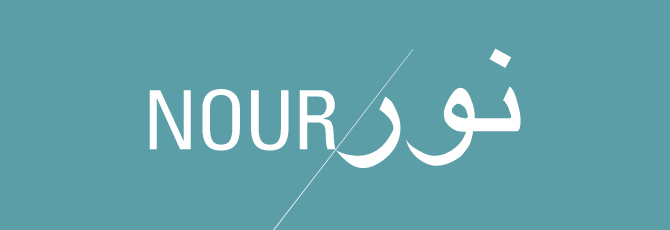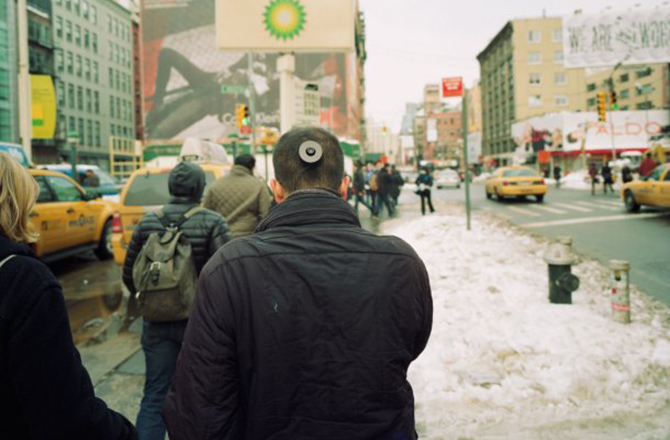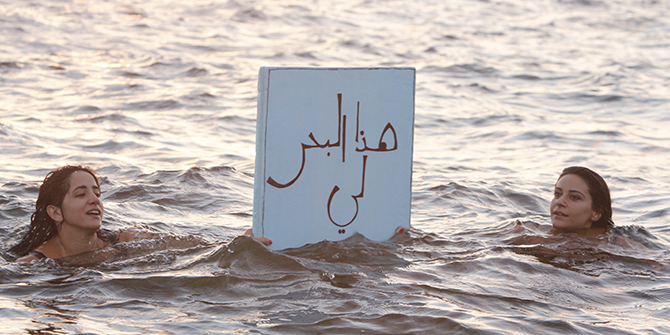by Aliya Say
 The Nour Festival of Arts has grown rapidly in the past six years, since its first inception by museum curators and public institutions in London’s Borough of Kensington & Chelsea in 2010. Bringing to light the rich array of artistic and cultural production coming out of the Middle East and North Africa today, the festival spans across three weeks and aims to act as a crucial meeting point for East
The Nour Festival of Arts has grown rapidly in the past six years, since its first inception by museum curators and public institutions in London’s Borough of Kensington & Chelsea in 2010. Bringing to light the rich array of artistic and cultural production coming out of the Middle East and North Africa today, the festival spans across three weeks and aims to act as a crucial meeting point for East
and West.
Contemporary art, theatre, music, cinema, food and literature are all on the menu, supplemented for the first time this year by a series of lectures and talks on art and culture from the MENA region. Five of these discussions have been put together by IESA UK: a graduate institute of art history and art market that has recently launched a new postgraduate programme on the history of artistic and cultural exchanges between the Islamic and the Western world. Questioning how artists, institutions and audience can interact in meaningful ways, the series presented four panel discussions on Art, Community and Engagement that took place at Leighton House Museum as part of the Festival.
What is the role of art in reshaping cultural landscapes and reclaiming public space in the big cities today? Can art change the perception of the Middle East formed by the popular media? Why engagement and diversity are the critical notions for museums in 2015? With topics ranging from the role of festivals, such as Nour and Shubbak, in countering the narrative presented by mainstream media and forming new grounds for cultural dialogue between communities and regions, to the study of art audience in multicultural Birmingham, ‘the no-go city for non-Muslims’, the talks aimed to reflect on what can art do today, in a broad sense, to engage, question and challenge. The series culminated this Tuesday 3 November with a lecture on Performance Art and Public Space presented by academic, writer and critic Dr Anthony Downey, editor-in-chief of Ibraaz, the highly progressive and forward-thinking critical forum on visual culture in North Africa and the Middle East, and followed by response from artist Tania El Khoury.
Who has access to public space? Who can speak within it? Where can you speak and whom do you speak to? ‘I am interested in public space as a civil sphere where civil society can come together’, Downey explained at the start of the lecture. In the following sixty minutes, he outlined the various ways in which artists in the Middle East are creating public sphere through a wide range of performative practices, and discussed how these practices can generate dialogues – and sometimes even conflicts.

Engaging works are not just about ‘people coming together in happy-clappy community-based practice’, argued Downey; sometimes they can present dissensual moments and reveal harsh antagonisms, such as in a 2009 performance by Egyptian artist Amal Kenawy Silence of the Lambs, when Amal hired fifteen labourers to crawl on their knees across a major Cairo intersection while herself dressed as an ‘urban shepherdess’. The performance immediately drew a large and not exclusively sympathetic crowd, ending up in a loud argument between the viewers and the participants, with the latter spending the next 24 hours in prison as a result.
Anthony discussed several projects by Wafaa Bilal, an Iraqi artist whose practice he is fascinated with. From The 3rdi in which a camera has been physically implanted on the back of the artist’s head recording an image every minute of his life for one year and one day, and transmitting all the images to a website for public consumption, to a month-long performance Domestic Tension in which the artist confined himself into a gallery space, while being subjected to almost never-ceasing attacks by a paintball gun controlled by the public through a dedicated website, Wafaa repeatedly creates a zone of confrontation between the real and the virtual, between the comfort zone and the conflict zone.

The representation of conflict and performance of conflict is unavoidably one of the key notions that comes up again and again: such as in Hiwa K’s performance This Lemon Tastes of Apple, in which the artist performed Ennio Morricone’s ‘Once Upon a Time in the West’ amidst the protest in Kurdistan in 2011, eventually putting himself in extreme danger as the demonstration grew more violent and the police started gassing protesters.
This Lemon Tastes of Apple. Hiwa K 2011 from Hiwa K on Vimeo.
In her response to the lecture, Tania El Khoury raised several highly relevant points. One of such relates to the notion of performing in public space, as opposed to staging a performance within the walls of an art institution: public space is by definition political, contested, gendered. ‘When you produce work within the institution, the boundaries are very respected’, argued Tania – not so when performing on the streets, where the audience is accidental and the interaction between the artist and audience can create tension, if not outright confrontation. Tania spoke about one such work This Sea is Mine that took place outside the safe realm of a museum or an art gallery. In this performance organised by Dictophone group, of which Tania is a co-founder, the participants boarded a small fishing boat to ‘explore the nature of ownership of the Beirut seafront’: the boat entered privately owned areas, usually only accessible by paying entrance fees, with Tania jumping in the water and holding a sign stating ‘This Sea is Mine’.

The notion of performing conflict in the Middle East has recently acquired a particular poignancy, heightened by the actions of the Islamic State (ISIS). The unquestionably performative nature of the videos of killings and the destruction of ‘inappropriate’ artefacts released by ISIS at regular intervals raises the questions of representation of conflict, the ownership of real and virtual public space, and the implication of the audience – in other words, the culpability of all of us as eager consumers of the ISIS brand.
As the world is fascinated by ISIS and by the imagery that it readily supplies, the artists are faced with an uneasy task: How can one create relevant work against the theatricality of conflict supplied by totalitarian regimes – asks Tania. How can artists counter this domination of public imagination by the images of atrocities released by the IS and multiplied profusely by the media? Can art produce a meaningful dialogue at a time when the whole world is hooked on the ISIS ‘TV series’? Perhaps art history knows one, if not definitive, answer: Abstract Expressionism.
Abstract Expressionism was born in the 1940s as a direct reaction to the atrocities of the war, and as a form of rejection of a world that has produced two barbaric World Wars, the Great Depression and the Holocaust. Disillusioned by humanity going through a tremendous moral crisis, some of the artists of the New York School found retreat in the philosophy of Existentialism and reverted to art removed from the quotidian. Though Abex can hardly be a solution to the 21st-century problem raised by Tania, perhaps it would be useful for all of us to reflect on the dissemination and consumption of images and meanings, on the ownership of public space, and ultimately the ownership of history today.
‘Vote with your dollar’ has so far proved the most effective technique in resisting the advance of big corporations – perhaps it is up to all of us to stop ‘buying’ images, histories, and opinions we are being fed, in the same way many stopped going to McDonald’s or using animal-tested cosmetics. Can artists realign the modes of consumption of meaning in our age of conflict and terror? Can art confronted with ‘Jihadi John’ and the Palmyra crisis tread a path in resisting the singularity of global cultural production? The task is burdensome and the stakes are high.
 Aliya Say is a writer and art critic passionate about contemporary art from the MENA region, and particularly interested in the intersections between politics and aesthetics, global food systems and sustainability. Aliya studied Art History and History of Collecting in Paris and London at l’IESA/University of Warwick, and is currently developing a postgraduate programme Encounters with Islamic Art. She tweets occasionally at @SayAliya.
Aliya Say is a writer and art critic passionate about contemporary art from the MENA region, and particularly interested in the intersections between politics and aesthetics, global food systems and sustainability. Aliya studied Art History and History of Collecting in Paris and London at l’IESA/University of Warwick, and is currently developing a postgraduate programme Encounters with Islamic Art. She tweets occasionally at @SayAliya.




